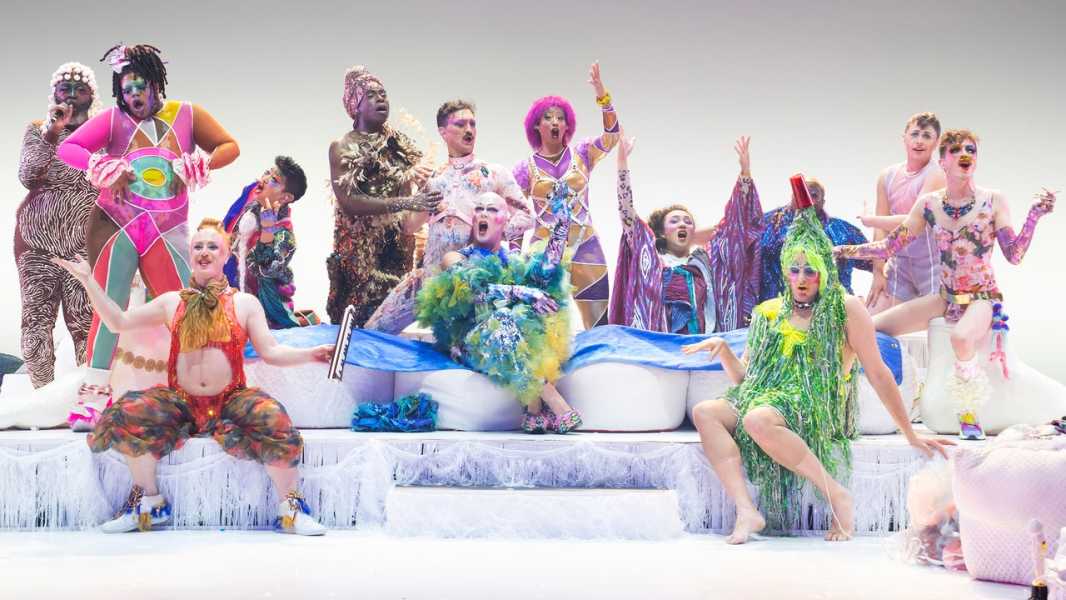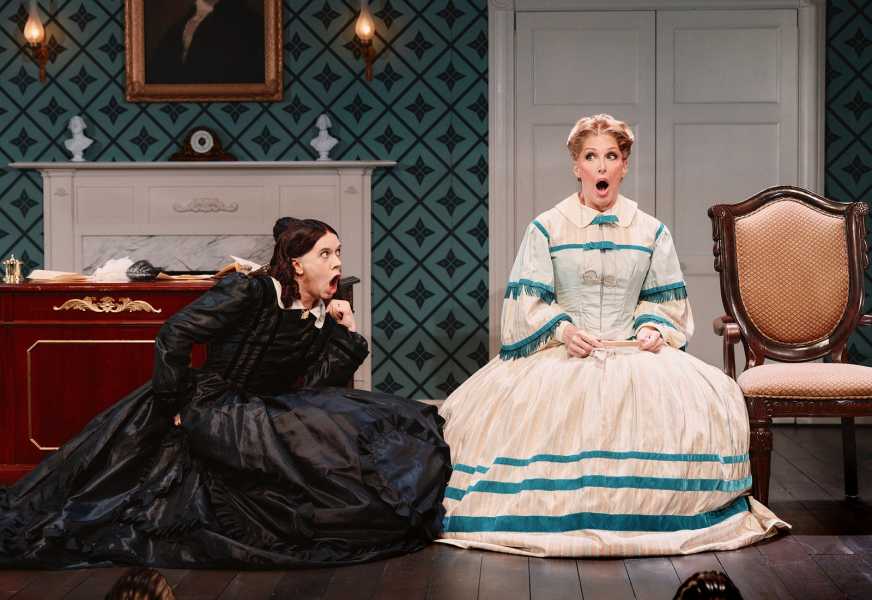
Save this storySave this storySave this storySave this story
“Welcome, queer babies, to this reverse-conversion-therapy session! Our goal this evening is to make you queer.” It was a Tuesday night at the Brooklyn Academy of Music, and the playwright and chanteuse Taylor Mac laughed throatily at the crowd, quite a few of them filtering in late, their sequins glittering. “Or . . . more queer.”
The more-than-four-hour-long psychedelic gorgeousness marathon “Bark of Millions,” co-created by Mac, the composer Matt Ray, and the costume designer Machine Dazzle, doesn’t use rhetoric to turn up our internal queer volume; its persuasion is less intellectual, more sensual. “Bark” consists of fifty-five songs, each one inspired by a different queer historical figure, performed without narrative or expository patter by a twenty-two-person ensemble. The effect is like a gender-explosive church service . . . though the congregation must imagine the sermon, and the priests wear elbow gloves and thongs. Song follows song follows song, and—unless we’ve memorized the online program beforehand—we won’t learn their titles or even the names of their subjects until afterward, when we can read the provided missal in the lobby. (It turns out they are tributes to Leonardo da Vinci, Marsha P. Johnson, and dozens of others, going back to the Egyptian god Atum.)
The show, directed by Mac, co-directed by Niegel Smith, and choreographed by Faye Driscoll, maintains a hazy, hotbox, listening-to-records-in-a-basement atmosphere, in part because of this manufactured incomprehension. Driscoll’s movement, too, emphasizes lassitude, getting the performers on their feet to groove mystically before they slump into puppy piles of stroking, sometimes dozy bodies. There’s also no intermission, though audience members may wander in and out if they choose. Ray, a composer of wild capacity, can write anything, from a heartbroken Elizabethan ballad to a disco anthem, but much of “Bark” is heart-pumping, piano-forward rock, and the guitar wails and jackhammer percussion add another layer of confusion. My ear for lyrics is so poor that I spent swaths of the production—swaths measured in hours, mind you—in tripped-out bewilderment, alternately annoyed and willingly submitting to the vibe.
Mac and Ray’s previous project, a jazzy opera called “The Hang,” from 2022, imagined Socrates’ final hours through the pastoral aesthetics of the Radical Faeries, whose countercultural movement intertwines queer liberation, communitarian spirituality, and a return to nature. (Harry Hay, one of the movement’s founders, gets a song in “Bark.”) Mac and Ray’s most famous collaboration is probably the daylong “A 24-Decade History of Popular Music,” but in “Bark” we seem very far away from that mega-cabaret’s pedagogical, encyclopedic, completist tactics. (You can get a sense of it from an HBO documentary that reduces the twenty-four-hour project to a tidy hour and forty-six minutes.) These projects exploited Mac’s particular gifts for audience-teasing charm and intellectual dazzlement—gifts that have been carefully excised here. Apart from that invitation at the beginning, Mac sings, but doesn’t speak.
When Mac made waves in 2006, with the spectacular “Red Tide Blooming,” a “side-show musical” inspired by the Coney Island Mermaid Parade, drag performance hadn’t hit the mainstream: “RuPaul’s Drag Race” wasn’t yet on TV, and pronouns—Mac uses the sui-generis “judy”—weren’t in the news. It’s been a long time since then, time enough for a few masterpieces. So, in “Bark,” Mac often seems content to kick back on a white, velvety pouf and listen to everyone else sing for a while. And why not? There are a dozen stunning voices here that can stop the show: the glorious Steffanie Christi’an, who has a Tina Turner-esque yell in her back pocket; Wes Olivier, who sings like a siren even when doing laps up and down the theatre’s stairs; Jack Fuller, a powerhouse who can make everybody in the room go still, by feathering a note with a hint of husky strain.
The costumes, by the brilliant Dazzle—a frequent collaborator of Mac’s whom Jess Barbagallo called a “sartorial poet,” in Artforum—summon much of the project’s meaning, especially in the wake of Mac’s withdrawal. Dazzle himself wears a cascading green A-line tinsel dress, which appears to fall out of a red plastic cup worn on his head—a reference to an important vomiting experience (beware of alcoholic slushies) in one of Mac’s songs. Christi’an wears a white peacock fan that rises up behind her head, part parade float, part bird; Chris Giarmo, who spends most of the night in a tummy-baring orange leotard, also wears a short jacket, with a painting on the back, re-creating Michelangelo’s image of God extending his finger toward Adam’s. (The nonchronological, everyone-all-at-once arrangement of historical “saints” in “Bark” ’s dramaturgy certainly recalls the dignified hodgepodge of the Sistine Chapel ceiling.) Mac begins the evening in fifties-hostess splendor: a wig of rose-colored tulle, pink cigarette pants, and a dress with panniers à la polonaise. The look is Lucille Ball, if she ever played Marie Antoinette in her shepherdess phase, and it made me realize that, over the decades, Mac has become our host slash shepherd slash queen figure: nurturing and majestic and wisely silly, and now, deliberately, letting the tiredness show.
The song cycle is subtitled “A Parade Trance Extravaganza for the Living Library of the Deviant Theme.” The key word there, I think, is “library.” The set is all white; the band’s music stands disappear behind falls of white fringe; objects’ edges dissolve inside the stage’s contextless, borderless blur. The white void, our visual shorthand for limbo, indicates that we are somewhere that is half Heaven, half archive. An archive saves things, but it also puts them away. Mac’s eyes look very far off, gazing on judy’s family of performers on the stage, who grow closer as we watch. The ecstatic group is all there, dancing and singing their hearts out, but I kept thinking that Mac seemed a little sad already—smiling in farewell, as if at a fond memory.

Cole Escola and Bianca Leigh in “Oh, Mary!,” at the Lucille Lortel Theatre.Photograph by Emilio Madrid / Courtesy Grapevine Productions
If you planned it out right, you could keep Mac’s “reverse conversion therapy” going all week. After BAM, you might zip into Manhattan for the comedian Cole Escola’s Off Broadway début—the Ludlamesque “Oh, Mary!,” at the Lucille Lortel Theatre—then over to La Mama for the choreographer-director Dan Safer and the Great Jones Repertory Company’s thoughtful “Aristotle Thinks Again.” If the fabulousness assembled on New York stages appears to have reached a critical mass, that may be because we’re having a little financial crisis in the theatre, and fabulousness has never had trouble making beauty out of the neglected, marginal, and underfunded.
Escola has a niche carved to their own peculiar specifications. They write (they won a Writers Guild of America Award for “At Home with Amy Sedaris”), they have a crackling television presence (they played the nasty-minded Matthew on Julie Klausner and Billy Eichner’s “Difficult People,” and a stalker on “Search Party”), and they filmed a whole weird character-work solo show in their apartment during the pandemic shutdown.
But the Lortel is clearly where they belong. Here, Escola wields their catty-scary shtick as a bitter, alcoholic burlesque of Mary Todd Lincoln, complete with big black dress and dangling Civil War-era ringlets, who barges through doors in the White House and through national sanctities. In the play, Mary’s much-tested Presidential husband, portrayed by Conrad Ricamora, tries to tell Mary that now isn’t the time for her to revive her cabaret career, but her narcissism is galactic:
Abraham: No! It’s inappropriate! We’re at war!
Mary: With who?
Abraham: The South!
Mary: Of what?
And—I can tell you no more. Escola’s jokes depend on surprise, and I can’t get between Mary and a punch line. (She would cut me.)
The Lortel has ghosts, though—ghosts from, for instance, Charles Busch’s “Red Scare on Sunset,” one of the playwright’s camp satires, performed there in the nineteen-nineties. Mary moves comfortably among those absurdist spectres. As naughty as “Oh, Mary!” can be, you feel its reverence for the queer auteurs that came before, if you also detect a little less for Honest Abe. Mac and Ray looked into history and found people to celebrate; Escola looked into history and found people to—metaphorically, of course—shiv. Anyway, there are a lot of ways to show love.
Speaking of love, the platonic collaboration between Safer and the playwright Chuck Mee has lasted a full decade, since Safer directed Mee’s “Eterniday,” in 2013. Mee’s plays are promiscuous assemblages as much as they are scripts: collages of found text (he adores lists) and his stream-of-consciousness odes to lazy afternoons spent sunk in romance. Safer started out as a go-go dancer, and approaches dance with total abandon and exuberance. “Aristotle Thinks Again” circles a central question: What if we survive the apocalypse? The answer is clearly to take pleasure in one another, and in the way our miraculous bodies move in space. The actor John Maria Gutierrez, even when disguised as a white businessman in a full-face mask, turns precipitate falls into rolls and handstands; the elegant Marcus McGregor, who danced with the Dance Theatre of Harlem and Feld Ballet, demonstrates the cautious poise of a fawn. Safer himself jumps over the footlights and joins in—turning from watcher to dancer in an instant. Just as Mac promised, conversion is easy; it takes only a step. ♦

Photograph by Maria Baranova / Courtesy La MaMa
Sourse: newyorker.com